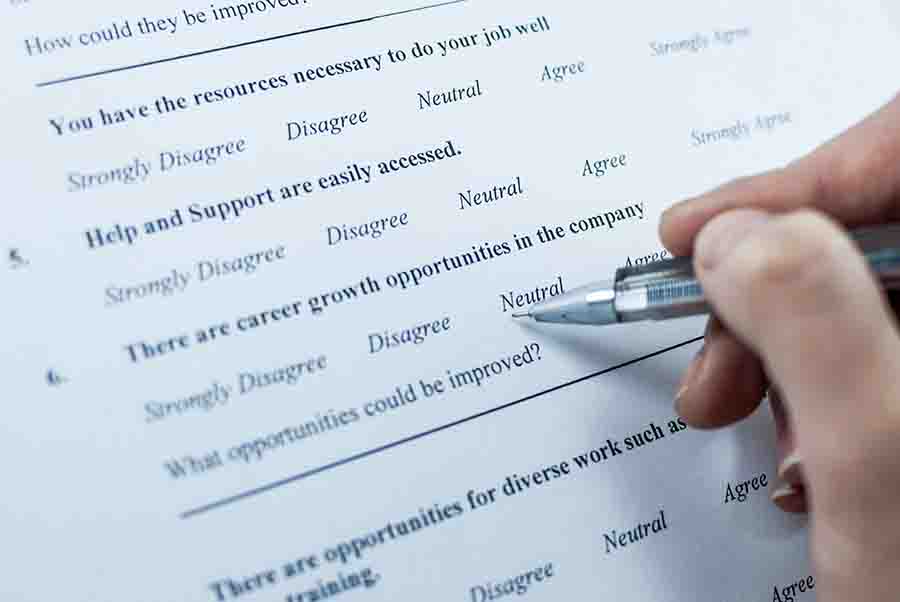Key Takeaways:
- Employee engagement survey questions can help you understand what workers think about the company culture and their roles in the organization among others.
- Responses to survey questions about employee engagement help you identify areas for improvement—so, choose questions on topics you want to focus on.
- Add multiple survey question types to get qualitative and quantitative answers for better data gathering.
- Use straightforward and clear questions to ensure that all survey respondents understand them.
Job Satisfaction & Role Clarity Questions
Job satisfaction and role clarity questions on an employee engagement survey aim to understand workers’ job happiness levels. Team members who are satisfied with their jobs are highly likely to be more engaged at work.
The following questions and suggested response types will help you understand the employees’ overall satisfaction with their roles and the different aspects of their jobs. Some of these questions can also provide insights into potential employee attrition issues due to job dissatisfaction, allowing you to come up with retention strategies for your team to help reduce turnover.
1.) How satisfied are you with your job?
Response type: Scale with Very Dissatisfied, Dissatisfied, Neither Satisfied nor Dissatisfied, Satisfied, and Very Satisfied options
2.) Do you know what is expected of you at work?
Response type: Yes or No options
3.) Do you feel that the work you do for the organization is meaningful?
Response type: Scale with Never, Rarely, Sometimes, Often, and Always options
4.) Do you enjoy working with your team?
Response type: Yes or No options
5.) Not including pay and benefits, do you consider job satisfaction as the key driver to make you stay or leave the company?
Response type: Yes or No options
6.) Do you see yourself still working for the company in two years’ time?
Response type: Yes or No options
7.) In the past 12 months, I thought about leaving the company.
Response type: Scale with Never, Rarely, Sometimes, Often, and Always options
8.) How can we help improve your job satisfaction level?
Response type: Free-form text response
Compensation and Benefits Questions
Knowing what your workers feel about their salary and benefits package will help you gauge whether your compensation plan and the different types of benefits you offer are sufficient or need improvement. Employees with unfair or uncompetitive wages are also more likely to feel disengaged at work and may consider leaving the company for better pay. While getting feedback directly from your workers will make it easier to pinpoint areas to focus on, you should also use salary survey tools to assess your salary and benefits plans’ competitiveness with market rates.
Here are some employee engagement survey questions for this topic.
9.) Are you satisfied with your current pay?
Response type: Scale with Very Dissatisfied, Dissatisfied, Neither Satisfied nor Dissatisfied, Satisfied, and Very Satisfied options
10.) Do you think that the benefits you receive meet your personal and family needs?
Response type: Scale with Strongly Disagree, Disagree, Neither Agree nor Disagree, Agree, and Strongly Agree options
11.) How satisfied are you with the performance-based bonuses or incentives offered?
Response type: Scale with Very Dissatisfied, Dissatisfied, Neither Satisfied nor Dissatisfied, Satisfied, and Very Satisfied options
12.) Do you have a clear understanding of the company’s salary and benefits policies?
Response type: Scale with Strongly Disagree, Disagree, Neither Agree nor Disagree, Agree, and Strongly Agree options
13.) Is there someone you can talk with at work if you have questions about your pay and benefits?
Response type: Yes or No options
14.) I think the company provides competitive pay and benefits compared to similar businesses in our industry.
Response type: Scale with Strongly Disagree, Disagree, Neither Agree nor Disagree, Agree, and Strongly Agree options
15.) What are the benefits you wish were improved or expanded?
Response type: Free-form text response
Workplace Culture Questions
Your employee engagement survey should have questions that focus on company culture. Aside from being a vital factor in helping you measure employee engagement, these questions will provide insights into what workers feel about the organization’s beliefs and core values.
If a majority of survey participants gave poor responses to these questions, you may want to hold a focus group discussion to get a better understanding of the underlying reasons. If it’s culture-related, consider forming an interdepartment culture committee to establish standards for employee behavior and develop policies that help foster a positive work culture. For other strategies, check out our article on company culture ideas to help boost engagement.
16.) I am proud to work for the company.
Response type: Scale with Strongly Disagree, Disagree, Neither Agree nor Disagree, Agree, and Strongly Agree options
17.) Do you think that the company has a positive workplace culture?
Response type: Yes or No options
18.) Will you recommend the company as a great place to work?
Response type: Yes or No options
19.) Do you feel that the organization encourages open communication?
Response type: Scale with Never, Rarely, Sometimes, Often, and Always options
20.) What can we do to improve our workplace culture?
Response type: Free-form text response
Management Support Questions
The way that you and your supervisors manage employees can greatly impact engagement. Employees are more likely to feel engaged if they receive support from their managers or supervisors. If a lot of the responses are negative, you may need to do a comprehensive check to determine the reasons behind these and create an action plan.
Let’s say you identified that most of the responses came from a team whose new manager has zero experience handling people. To address this, have the manager join a leadership training program and set up monthly check-ins after the training to see how the manager is doing. If you have a mentorship program that partners employees with seasoned professionals in the organization, you can also enroll the new manager there.
Below are some employee engagement survey questions to help you assess worker happiness given the care and respect they receive at work.
21.) Do you feel that your supervisor or manager cares about you as a person at work?
Response type: Yes or No options
22.) How comfortable are you providing feedback to your manager?
Response type: Scale with Very Uncomfortable, Uncomfortable, Neither Comfortable nor Uncomfortable, Comfortable, and Very Comfortable options
23.) Do you believe that your manager values the feedback that you give?
Response type: Scale with Never, Rarely, Sometimes, Often, and Always options
24.) I feel that my manager’s support helps me become successful in my role.
Response type: Scale with Strongly Disagree, Disagree, Neither Agree nor Disagree, Agree, and Strongly Agree options
25.) Do you think your manager communicates clear goals to you and the team?
Response type: Yes or No options
26.) In which situations do you feel your manager demonstrates care for you at work?
Response type: Free-form text response
Recognition and Development Questions
A survey for employee engagement won’t be complete without questions that ask about training and development and employee recognition. These provide insights into your career advancement initiatives, allowing you to understand pain points and address problem areas, such as unclear career paths. Plus, adding these questions to your employee engagement questionnaire can help you gauge whether your workforce’s achievements are appreciated or if they receive the training support they need.
27.) Do you feel recognized and appreciated for your work contributions?
Response type: Yes or No options
28.) How frequently do you receive recognition from your manager for a job well done?
Response type: Scale with Never, Rarely, Sometimes, Often, and Always options
29.) I regularly receive coaching from my manager about my job performance.
Response type: Scale with Strongly Disagree, Disagree, Neither Agree nor Disagree, Agree, and Strongly Agree options
30.) In the last 12 months, did you get opportunities at work to learn and develop your skills?
Response type: Yes or No options
31.) I see a clear path for career advancement in my role.
Response type: Scale with Strongly Disagree, Disagree, Neither Agree nor Disagree, Agree, and Strongly Agree options
32.) What kind of career development support would you like to be offered?
Response type: Free-form text response
Work-life Balance Questions
With work-life balance questions, you get an idea of how your workers are balancing the demands of their jobs with their personal lives. Responses to these questions can help you reduce employee burnout by spotting early signs, such as unmanageable workload, which can push team members to extend work hours or bring their unfinished tasks home. The survey answers will also help you identify whether you need to conduct training sessions to improve the people management skills of your team leaders in case their poor team management is one of the drivers of low work-life balance.
33.) Do you have time and energy for your personal life outside of work?
Response type: Yes or No options
34.) In the last six months, I missed a personal event or canceled paid time off (PTO) due to work.
Response type: Scale with Never, Rarely, Sometimes, Often, and Always options
35.) How would you rate your work-life balance?
Response type: Scale with Very Poor, Poor, Neither Good nor Poor, Good, and Very Good options
36.) How many hours do you work on average per week?
Response type: Free-form text response
37.) If you experience poor work-life balance, what are the biggest contributors?
Response type: Multiple choice, where respondents can choose all that apply. It can also include a free-form text response as the final answer option. Sample choices can be: poor time management, unequal work distribution, and limited manpower due to high turnover.
Work Environment Questions
These types of employee engagement survey questions provide insight into what team members think about their physical work environment and the resources available to them. It also helps you determine whether your workers have the essential materials and systems they need to become efficient in their roles.
If after running the survey, you see a lot of negative responses to these questions, take a look at the resources you provide as these may not be enough to meet your workers’ needs. If you have a physical workplace, you may need to make improvements to make it more functional or accessible. Also, check your budget if you can add a staff pantry room stocked with snacks, juices, and coffee. These changes can help improve employee morale and engagement.
38.) Most of the systems, equipment, and resources at work support me in getting my job done effectively.
Response type: Scale with Strongly Disagree, Disagree, Neither Agree nor Disagree, Agree, and Strongly Agree options
39.) Are there spaces in the workplace where you can rest and chat with others when you need a break?
Response type: Yes or No options
40.) How satisfied are you with the functionality of the company workplace and the amenities or facilities provided?
Response type: Scale with Very Dissatisfied, Dissatisfied, Neither Satisfied nor Dissatisfied, Satisfied, and Very Satisfied options
41.) What other resources or equipment do you need to help you do your job well?
Response type: Free-form text response
Employee Engagement Survey Question Types
In building an employee survey, determining the types of question formats to use will help you gather and analyze the data you need. Here are some of the most common types.
1.) Multiple choice questions: These are questions or statements with a predefined list of responses.
Examples:
- Most of my values match those of the company’s.
Yes
No - Which of these working arrangements will contribute the most to my overall job happiness and engagement levels?
Fully remote work or work-from-home arrangement
Hybrid with the option to work partly from home or remotely and at the office for specific days in a workweek
Fully on-site work at the office
2.) Rating scale questions: These require respondents to indicate their level of satisfaction, agreement, frequency, likelihood, and other categories based on a numerical scale.
Examples:
- On a scale of 1 to 5 with 5 being the highest, how would you rate the level of collaboration within your team?
- On a scale of 1 to 10 with 10 being highly satisfied, how satisfied are you with your current job and responsibilities?
3.) Likert scale questions: These questions use a rating scale with specific responses to measure the survey respondents’ opinions, feelings, and attitudes on various topics.
Examples:
- Does your manager inspire you to do your best work?
Never
Rarely
Sometimes
Often
Always - I have a good understanding of the company’s promotion policies.
Strongly Disagree
Disagree
Neither Agree nor Disagree
Agree
Strongly Agree
4.) Open-ended questions: These require answers in text format, allowing respondents to freely answer the survey question.
Examples:
- What is your favorite thing about the company’s work culture?
- Which of the company’s employee engagement initiatives do you like the most? Which do you like the least?
Frequently Asked Questions (FAQs)
Employee engagement surveys are important because they provide insight into what your workers feel about different aspects, such as job satisfaction, manager effectiveness, recognition, and workplace culture.
The ideal timeline is every year or twice a year. However, you can run this quarterly, especially if you want frequent feedback from employees to help you identify and avoid potential issues from becoming big problems.
There isn’t a right or wrong number when it comes to the length of staff surveys. This can vary depending on your goal for running the survey, the types of questions used, and the target respondents. However, you should aim for around 20 to 30 questions for a long-form survey or about 10 to 15 questions for short surveys that respondents can complete in as fast as 10 minutes. To streamline the survey sending and collection process, consider using survey software. For options, check out our list of the best employee survey tools.
Designing what your employee engagement survey will look like involves several factors. Determining your survey goals and respondent demographics is key, as well as selecting the right type of survey questions to use. You should also consider the length of time that respondents will fill out your survey to ensure high participation rates and prevent employees from feeling bored with the many questions they need to answer.
Both surveys allow you to evaluate how current company practices influence worker engagement and satisfaction. However, a survey that utilizes employer net promoter scores (eNPS) is shorter and typically uses just one question to determine the likelihood of your employee recommending your company as a great place to work. While you can run eNPS surveys quickly, it doesn’t provide as much information about disengagement factors and other issues as the usual engagement surveys. These typically feature a lot of questions, including a mix of question types.
Employee engagement isn’t synonymous with employee satisfaction—but the two are related, which is why most engagement and satisfaction surveys ask the same questions. Employee satisfaction measures how happy workers are with their jobs, pay, benefits, and workplace environment; whereas, employee engagement measures the workers’ commitment to their jobs and the organization and how much effort they’re willing to expend to do good work.
However, addressing issues that impact employee satisfaction will have the same effect on employee engagement. When workers feel engaged and happy, they are more enthusiastic about the work they do, which can improve business performance, productivity, and staff retention.


